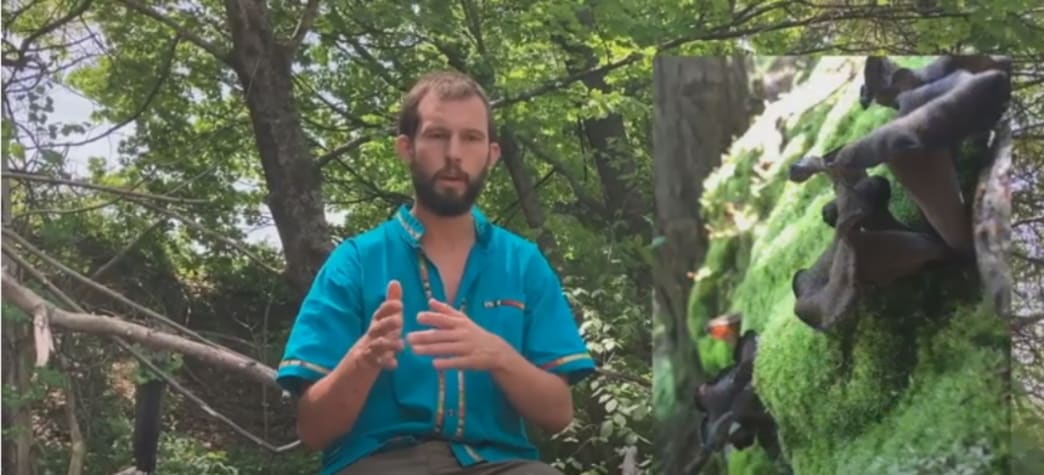Want edible wild mushroom identification pictures & video?! Find it here and discover chicken of the woods, maitake, oysters, black trumpets, chanterelles, and morels!
People often ask about how to identify mushrooms while they go out in the woods to find mushrooms, so we are providing some edible wild mushroom identification pictures and an extensive video in this article.
The first thing I want to say is that foraging for me is now intertwined into my life. If I'm driving, I'm foraging. If I'm going for a swim, I’m foraging. If I'm spending time with friends, I’m always looking for mushrooms because they're everywhere!
It's not like mushrooms only live deep in the woods. You can find them in cities and parks and right next to the road. So the first step is to open your eyes to seeing mushrooms and allowing that lens to turn on. Let that curiosity come out. And now with apps like iNaturalist or online forums, it's easier to make an identification. If you are really focused on going out to find a wild edible mushroom, then the first thing to know is when does the mushroom fruit and where does it like to fruit.
So in this video of edible wild mushroom identification pictures, we're gonna talk about five or six really common, easy to find and easy to identify wild edible mushrooms. After watching you'll have the confidence and understanding when and where to look for these mushrooms, as well as key features to look for to know if it is the right mushroom.
The mushroom itself is a temple of copulation where sexual reproduction happens. The first thing you look at when you're thinking about how to identify the mushroom is: where are the spores located.
The first mushroom documented in the video is an artist conk. Underneath are little pores that spores -- the offspring of the mushroom -- are dropping out of. There are other mushrooms that are really common that have gills or teeth or puff balls, which are basically a ball of spores. There's lots of different ways that mushrooms disseminate their spores, but that's your number one thing to look at when thinking about identification.
Next up is getting more details of the mushroom. What are the colors of the mushroom? What is it growing out of? Is it a cap and stem or is it like a shelf fungus like the artist conk. Those are all really important things to look at for identification.
Let's walk through the six really easy to know edible wild mushroom identification pictures in this videos
1. Chicken of the woods (Laetiporus sp.) is one of the best ones to know. It fruits abundantly and is super easy to identify. It grows primarily on oak, anywhere from living to dead trees and pretty decomposed. It's a shelf fungus that grows out the side of the tree. The top is a bright orange color, and the bottom is either yellow or white. There are pores on the bottom.
Chicken of the woods is really tasty, especially when it's a young mushroom. It fruits a fair amount of the year up here in New England, basically from May all the way through November. In the September/October range is when you find the most of it.
It is delicious stir-fried, grilled or baked. You can bread it and make “chicken nuggets”. What I really like about it is you can find many pounds of it. Chicken of the woods can fruit year after year in the same spot, so say you find it July 15th one year, then I would start going back to that spot like a week before a week after to check and see if it's coming up again.
2. Hen of the woods is a totally different mushroom, and a different “poultry” of the woods. Hen of the woods (Grifola frondosa) has another common name: maitake. Maitake is a Japanese word that means “dancing mushroom”, perhaps because you might do a happy dance when you find it growing in the wild.
In the US, maitake fruits almost exclusively in the midwest to the east coast. It fruits at the base of big old oak trees in September or October. There's a couple of lookalikes that aren't poisonous, but people confuse maitake with black staining polypore
Maitake fruits out of one stem and then it has all these little leaflets that branch out from it. Maitake is a polypore that is typically gray/white with a blackish color on top and white on the bottom. Maitake is a little bit more firm than chicken of the woods, and it is also really good breaded, fried or sautéed. Maitake is also an amazing medicinal mushroom, so drying it, making tea, and making tinctures is fantastic for this mushroom. You can also grow maitake at home as well!
Watch the video of edible wild mushroom identification pictures to learn more about the third, fourth, fifth, and sixth mushrooms on this list! These start around the 7 minute mark of the video. They include:
3. Oyster mushrooms!
4. Black trumpet mushrooms!
5. Chanterelle mushrooms!
6. Morel mushrooms!

